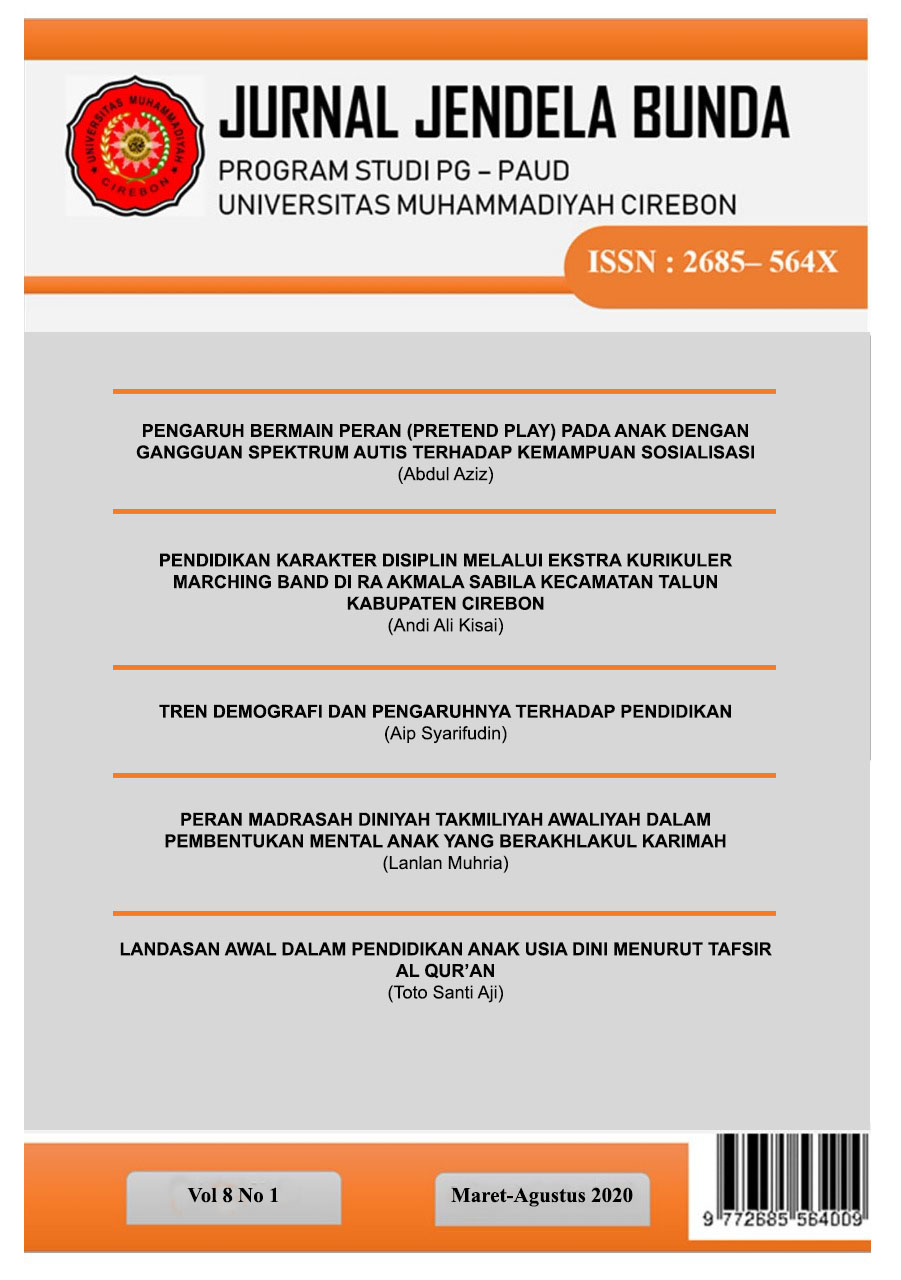PENGARUH BERMAIN PERAN (PRETEND PLAY) PADA ANAK DENGAN GANGGUAN SPEKTRUM AUTIS TERHADAP KEMAMPUAN SOSIALISASI
DOI:
https://doi.org/10.32534/jjb.v8i1.1076Abstract
Penelitian ini bertujuan untuk menguji hubungan bermain pura-pura pada anak dengan gangguan spektrum autis (GSA) dengan kemampuan sosialisasi. Anak dengan GSA memiliki gejala utama seperti keterbatasan sosialisasi. Gejala tersebut dapat menyebabkan kesulitan dalam bermain. Bermain peran memberikan kesempatan pada anak untuk melakukan suatu kondisi yang terjadi dalam kehidupan sehari-hari dan sosialnya. Metode penelitian yang digunakan adalah metode penelitian kuantitatif dengan rancangan penelitian korelasional. Jumlah sampel dari penelitian adalah 20 anak dengan GSA usia 3 – 7 tahun yang dilakukan tes dengan menggunakan ToM test, ChIPPA (Child-Initiated Pretend Play Assessment “pretend play condition”), dan CARS (Childhood Autism Rating Scale). Penelitian ini dianalisis dengan analisis regresi menggunakan SPSS versi 21.0. Penelitian ini menggunakan statistik deskriptif dengan menjelaskan karakteristik demografi, ToM, dan bermain pura-pura dari partisipan. Koofisien korelasi pearson digunakan untuk mengetahui korelasi antara variabel ToM, tingkat keparahan autistik, dan bermain pura-pura. Hasil analisis regresi menegaskan bahwa ToM secara signifikan memprediksi bermain pura-pura, yakni jumlah substitusi objek (R2 = 0,158, p = 0,002) dan jumlah tindakan meniru (R2 = 0,175, p = 0,001). Dengan demikian, anak dengan GSA yang memiliki ToM yang baik biasanya mengembangkan kemampuan bermain pura-puranya secara baik. Akhirnya, peneliti menyimpulkan adanya peningkatan kemampuan sosial pada anak dengan GSA dengan mengikuti bermain peran (pretend play).
Kata Kunci :Pretend Play, Autis, Kemampuan Sosialisasi
References
Baron-Cohen, S. (1997). Mindblindness: An essay on autism and theory of mind. Cambridge, MA: MIT Press.
Baron-Cohen, S., Ashwin, E., Ashwin, C., Tavassoli, T., & Chakrabarti, B. (2009). Talent in autism: Hyper-systemizing, hyper-attention to detail and sensory hypersensitivity. Philosophical Transactions of the Royal Society of London. Series B, Biological sciences, 364, 1377–1383.
Baron-Cohen, S., Lombardo, M. V., Auyeung, B., Ashwin, E., Chakrabarti, B., & Knickmeyer, R. (2011). Why are autism spectrum conditions more prevalent in males? PLoS Biology, 9, e1001081.
Brock, S. E., Jimerson, S. R., & Hansen, R. L. (2006). Identifying, assessing and treating autism at school. New York: Springer.
Breidbord, J., & Croudace, T. J. (2013). Reliability generalization for childhood autism rating scale. Journal of Autism and Developmental Disorders, 43(12), 2855-2865.
Chan, P. C., Chen, C. T., Feng, H., Lee, Y. C., Chen, K. L. (2016). Theory of mind deficits is associated with pretend play performance, but not playfulness, in children with autism spectrum disorder. Hong Kong Journal of Occupational Therapy, 28, 43-52.
Cooper, R. J. (2000). The impact of child abuse on children’s play: a conceptual model. Occupational Therapy International, 7, 259–276.
Eaves, R. C., & Milner, B. (1993). The criterion-related validity of the childhood autism rating scale and the autism behavior checklist. Journal of Abnormal Child Psychology, 21(5), 481-491.
Feng, H. (2001). Organization of theory of mind (ToM) test, the development of ToM in children with autism, and the effect of ToM training on social skills in children with high-functioning autism in central Taiwan. National Science Council Project Reports: NSC89-2413-H-018-026.
Ginsburg, K. R. (2007). The importance of play in promoting healthy child development and maintaining strong parent-child bonds. Pediatrics, 119, 182–191.
Hsu, C. L. (2007). The difference between attention deficit/hyperactivity disorder and high-functioning autism in Theory of Mind abilities (Master). New Taipei City, Taiwan: Fu Jen Catholic University.
Lam & Yeung. (2012). Cognitive deficits and symbolic play in preschoolers with autism. Research in Auism Spectrum Disorders, 6, 29-38.
Lantz, J. (2001). Play time: an examination of play intervention strategies for children with autism spectrum disorders. The Reporter, 6, 1–7.
Lewis, V., Boucher, J., & Astell, A. (1992). The assessment of symbolic play in young children: a prototype test. European Journal of Disorders of Communication, 27(3), 231-245.
Lillard, A. S., Lerner, M. D., Hopkins, E. J., Dore, R. A.,Smith, E. D., & Palmquist, C. M. (2013). The impact of pretend play on children’s development: A review of the evidence. Psychological Bulletin, 139(1), 1-34.
Matson, J. L., Mahan, S., Hess, J. A., Fodstad, J. C., & Neal, D. (2010). Convergent validity of the autism spectrum disorder diagnostic for children (ASD-DC) and Childhood Autism Rating Scales (CARS). Research in Autism Spectrum Disorders, 4(4), 633-638.
McCune-Nicolich, L. (1981). Toward symbolic functioning: Structure of early pretend games and potential parallels with language. Child Development, 52(3), 785-797.
Parham, L. D. (2008). Play in occupational therapy for children. St. Louis: Mosby.
Rubin, K. H., Fein, G. G., & Vandenberg, B. (1983). Play. In P. H. Mussen (Ed.), Handbook of child psychology: Socialization, personality and social development (4th ed., pp. 695-774). New York: Wiley.
Saunders, I., Sayer, M., & Goodale, A. (1999). The relationship between playfulness and coping in preschool children: a pilot study. The American Journal of Occupational Therapy, 53, 221–226.
Schopler, E., Reichler, R., & Rochen, R. B. (1988). The childhood autism rating scale (CARS). Los Angeles: Western Psychological Services.
Schopler, E., Reichler, R. J., & Renner, B. R. (1994). The Childhood autism rating scale. Wilshire Boulevard, Los Angeles: Western Psychological Services.
Stagnitti, K., Rodger, S., & Clarke, J. (1997). Determining gender-neutral toys for assessment of preschool children’s imaginative play. Australian Occupational Therapy Journal, 44(3), 119-131.
Stagnitti, K., & Unsworth, C. (2000). The importance of pretend play in child development: An occupational therapy perspective. The British Journal of Occupational Therapy, 63(3), 121-127.
Stagnitti, K., Unsworth, C., & Rodger, S. (2000). Development of an assessment to identify play behaviours that discriminate between the play of typical preschoolers and preschoolers with pre-academic problems. Canadian Journal of Occupational Therapy, 67(5), 291-303.
Stagnitti, K. (2001). The play of children with developmental delay and typically developing children as measured on the Child Initiated Pretend Play Assessment. Paper presented at the Paediatric Occupational Therapy Conference, Sydney.
Stagnitti, K., & Unsworth, C. (2004). The test-retest reliability of the Child-Initiated Pretend Play Assessment. The American Journal of Occupational Therapy, 58(1), 93-99.
Stagnitti, K. (2007). Child-Initiated Pretend Play Assessment (ChIPPA). Manual and kit. Melbourne, Australia: Co-ordinates Publications.
Sutton-Smith, B. (1980). Children’s play: Some sources of play theorizing. New Directions for Child and Adolescent Development, 1980, 1–16.
Swindells, D., & Stagnitti, K. (2006). Pretend play and parents’ view of social competence: The construct validity of the Child-Initiated Pretend Play Assessment. Australian Occupational Therapy Journal, 53(4), 314-324.
Vygotsky, L. S. (1976). Play and its role in the mental development of the child. Journal of Russian and East European Psychology, 5, 6-18.
Westby, C. E. (1991). A scale for assessing children’s pretend play. Play Diagnosis and Assessment, 131-161.
Wieder, S. (2012). Foreword. In Gallo-Lopez, L. & Rubin, L. C. (Eds.). Play-based interventions for children and adolescents with autims spectrum disorders (pp. xi-xiv). London, England: Routledge. Taylor & Francis Group.
Williams, E., & Kendell-Scott, L. (2006). Autism and Object Use: The Mutualitiy of the Social and Material in Children’s Developing Understanding and Use of Everyday Objects. In A. Costall & A. Dreier (Eds.). Doing Things with Things. Design and Use of Ordinary Objects (pp. 51-66). Farnham, England: Ashgate Publishing Group







